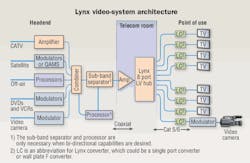All-digital hospital stays connected with Category 6
IT, telecom, and television systems run over twisted-pair cabling in this 110-bed facility.
Dwight Erdmann calls it "patch and add," because all he has to do is connect a television to the Category 6 network and it's ready to go. "It's really convenient to have everything running on a single network," he says. Delivering television on Category 6 cabling is one of the many leading-edge technologies used by patients, visitors, and staff at Ministry Health Care's Saint Clare's Hospital in Weston, WI where Erdmann is communications planning analyst.
The 110-bed facility opened in October 2005 and was one of the first hospitals in the nation to go all-digital, including a chartless patient information system, campuswide wireless telecommunications, and data systems. Patients can order movies on demand, view programming on more than 20 entertainment channels, as well as regional sports networks that carry the Milwaukee Brewers and University of Wisconsin Badgers. One of the most important tools for physicians at St. Clare's is wireless tablet computers, because the traditional patient chart or clipboard is a thing of the past.
The hospital is part of Ministry Health Care, a network of 15 hospitals, clinics, long-term care facilities, home-care agencies, dialysis centers, and other programs and services in Wisconsin and Minnesota. Headquartered in Milwaukee, the organization traces its roots back to a small group of Catholic sisters in the late 1800s.
One for all
A major goal in designing the hospital was to operate all TV programming, information technologies and telecommunications systems over a single, converged network according to Jeff Lee, senior telecommunications designer at Hammel, Green, and Abrahamson Inc. (www.hga.com). The nationally recognized Minneapolis architectural and engineering firm has a strong reputation for designing medical facilities. They include the Mayo Clinic's College of Medicine Simulation Center in Rochester, MN; the Kaiser Permanente Medical Office Building in Monterey, CA; and the Ohio State University's Richard M. Ross Heart Hospital in Columbus, OH.
Dwight Erdmann with a Lynx hub in one of Saint Clare's Hospital's intermediate crossconnects.
"One of the new capabilities that St. Clare's wanted was a state-of-the-art television distribution system, either an RF signal over unshielded twisted-pair cable, or possibly Internet Protocol TV," Lee says. With all this in mind, HGA specified Category 6 cable to carry television signals from the intermediate crossconnects (ICs) to patient rooms.
HGA also recommended a Lynx Video Network from Lynx Broadband as the centerpiece of the Saint Clare's television distribution system. "We recommended Lynx because you can run it over traditional cabling that's used for data," Lee says.
Erdmann was even more enthusiastic: "The flexibility with Cat 6 is just phenomenal," he says. "Any place we have a data jack, we can have a TV set there too."
The main source of programming is a satellite with high-frequency signals traveling over coaxial cable from the dish on the roof to the headend on the top floor. Blonder Tongue (www.blondertongue.com) equipment remodulates the signals to lower-frequency RF channels, which are delivered over RG-11 cable to 20 ICs where Lynx hubs are located.
Saint Clare's has 15, 8-port and 9, 16-port Lynx hubs, which have the capacity to deliver television signals to 264 monitors. One port on each hub delivers a signal to one TV via one Category 6 cable.
At the point of use, a small Lynx converter changes the television signals back to coaxial form for delivery to the TV set. The hospital has 184 single-port converters and the capacity to add 80 more when needed.
Lynx equipment incorporates broadband baluns and several common-mode chokes. The baluns convert unbalanced coaxial signals into balanced signals that travel on pair four of the unshielded twisted-pair cables.
"We get good, sharp pictures on the 23-inch flat-screen TVs in all the patient rooms and on 27-inch TVs in patient waiting rooms," says Erdmann, who for 23 years worked for an audio/video company before joining Saint Clare's approximately four years ago. "The signal is as good as or better than we could get with coax. We also have TVs in the ER department, birth center, diagnostic and treatment center, and lobbies."
Recently the hospital added a new family waiting area to its intensive care unit. The waiting area features a 32-inch flat-screen TV for patient education and entertainment, which is also hooked up through Lynx.
These schematic depicts the architecture of a Lynx video system like the one deployed within Saint Clare's Hospital.
"Anywhere there is a data jack, we can plug in a TV set and have a picture on the screen in minutes," Erdmann continues. "Besides the convenience and time savings, there is no extra cost for wiring another jack or installing another type of cable network in the building."
Timing is everything
Lee and his colleagues at HGA were well into telecommunications planning and design for Saint Clare's in the fall of 2003 when they attended a meeting of North Central Electrical League (www.ncel.org). A timely presentation by Lynx Broadband at that event introduced the HGA group to the concept of delivering television on twisted-pair cable, which they thought might be applicable to the Saint Clare's project.
They had concerns, however, about maintaining signal strength and picture quality over long distances. That became a moot issue after learning Lynx delivers a quality signal up to 300 feet on Category 6 cable. Because the ICs at Saint Clare's are an average of 150 feet from patient rooms, distances for TV signals to travel were well within limits.
The idea that the Lynx system was a baseband solution caused initial concern about its ability to carry numerous channels; that concern was quieted when the planners learned the Lynx system used broadband technology and is capable of delivering 70 channels to each TV in the hospital.
"Lynx certainly met all of my expectations," says Lee, who has been with HGA for eight years and was previously an IT staffer ad Hutchinson Technologies and Wells Fargo for five and ten years, respectively.
"However, you've got to think a little differently when designing a Lynx network, because it requires a stronger signal than a traditional trunk-and-tap coax system. We were told about this up front and understood how it could easily be solved with larger amplifiers at the headend."
The cost factor
"There is a little more initial cost to buying and installing a Lynx system, but it isn't significant," Lee says. The Lynx Video Network at Saint Clare's cost about $45,000 compared to the $40,000 that a conventional coaxial system would have cost.
"However, when compared to the overall telecom cabling infrastructure for the entire hospital, which was around a half-million dollars, the additional $5,000 is quite small," Lee explains. The total cost included the satellite dish and equipment, all Category 6 cable and jacks, equipment racks in each of the 20 ICs, racks and cable trays in the data center, Lynx equipment, installation, and testing.
"It never really came down to cost on this project," Lee continues. "Rather, it came down to performance and functionality. There is a little more cost with Lynx, but most building owners will recoup those extra costs in a hurry by avoiding the installation of any coax in the future."
Erdmann agrees, stating, "In the long run, Lynx is a better system. I was approached a while ago by one of our sister hospitals that wanted to renovate and put in a coax system. I said, ‘If you're planning for the future, why not install Cat 6 now, in order to be prepared for future technologies that will run on Cat 6 cable, like Internet Protocol TV?'"
Although the hospital has been in operation a relatively short time, it already has been listed by Hospitals & Health Networks magazine as one of America's 100 "most wired" hospitals for its use of digital information technology. Recognized by the hospital-rating organization Leapfrog Group (www.leapfroggroup.org) as one of America's best value hospitals, Saint Clare's anchors the Weston Regional Medical Center campus, which is just minutes from Wausau in the heart of central Wisconsin.
Gregg Kelley is national sales and marketing manager for Lynx Broadband (www.lynxbroadband.com).
More Cabling Installation & Maintenance Current Issue Articles
More Cabling Installation & Maintenance Archives Issue Articles




